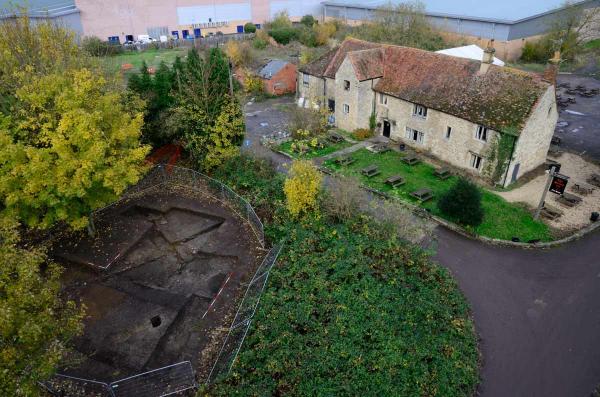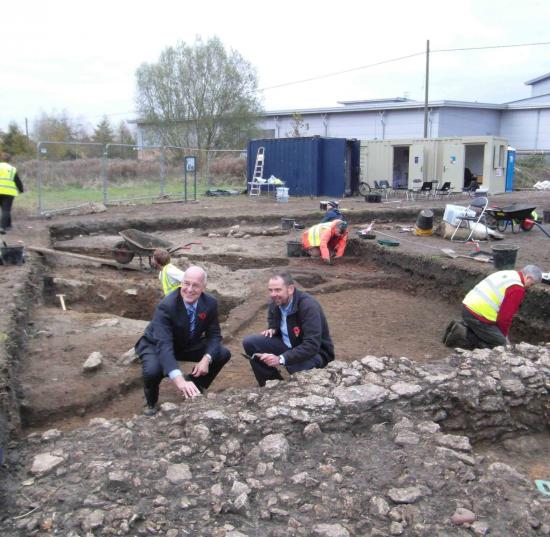Minchery

Minchery Farm Paddock excavation, trench 2, Nov 2012
(c) Aerial Cam
The Minchery area between Littlemore and the Kassam stadium has been a major focus for the Archeox project. Work in this area has included a test pit at East Minchery Farm and the second of the project's major excvations on the site of the Medieval priory at Minchery Farm Paddock in autumn 2012. Post-excavation work is currently underway and results will be posted here when complete. To get involved with the post-excavation analysis and write up contact the project here. As the individual elements of the post-excavation process are completed they are uploaded to the website here.
The excavation
After a summer spent looking for a suitable excavation site for 2012, in mid-September Oxford City Council gave the project permission to dig on their land at Minchery Farm Paddock, close to the Kassam stadium, between Littlemore and Blackbird Leys. The paddock is known to over lie the remains of Minchery Priory (founded in the 12th century), and previous work on the site had also produced evidence of Roman and prehistoric activity. A couple of very busy weeks ensued, finalising permissions, ordering site infrastructure and clearing vegetation. After an initial set up week the site opened to volunteers on 9th October. Over the course of the next five weeks three very different trenches were excavated.
Trench One was excavated at the northern end of the site to investigate waterlogged deposits associated with the Northfield Brook. As well as being the smallest it was also the soggiest, muddiest and probably the least popular trench. Four weeks of battling with a high water table and a temperamental pump revealed a 1m deep peat deposit with good potential for palaeoenvironmental analysis. This was in part overlain by a spread of stone slabs associated with Roman pottery, tiles and animal bone.

Minchery Farm Paddock excavation, trench 3, Nov 2012
(C) Aerial Cam
The rich archaeology of Trench Two was a bit of a surprise: we didn’t expect so many buildings, a big ditch or prehistoric flints. The walls and the large hearth, probably for smithing iron, were revealed with artefacts and pottery from the 12th – early 16th centuries. So the buildings were in use within the same life span as the Priory and were likely to have been part of the Priory farm or of a manor linked to it. Apart from some early 21st century archaeology (left by car-burners and archaeologists) nothing found in the trench was later than the early 16th century. After the dissolution of the Priory this area must have been used continually as a paddock or field.
Across the south of the trench ran the foundations and lower courses of a well-built wall almost a metre high, which had been partially but carefully demolished, probably at time the Priory was dissolved. In its construction this wall was very similar to the 14th century Chapel at Bartlemas – including a distinctive relieving arch. The finds relating to this building included
fine pottery, metalwork, decorated tiles and animal bones suggesting he building was domestic. Running NE to SW across the trench and west of the buildings was a ditch, c 2.5m wide and at least 1.2 m deep. This ditch, even if it originated as a natural watercourse, had also been altered by people. Was it a moat or a channel taking water to fishponds? That water would certainly have been useful to those working in the smithy in the east of the trench. A wide line of vertically laid cobbles provided foundations for two post bases and may have supported a wooden superstructure. Post-holes in the trench suggested this may have been part of a partially open-sided but roofed building over the large smithing hearth. The hearth itself was beautifully built using large stone slabs and vertically laid tiles.
The medieval buildings had disturbed traces of prehistoric activity: an exquisite Early Bronze Age flint barbed and tanged arrowhead was found amidst the demolition rubble as well as several scrapers, cores and blades, at least some of which were older, in other medieval contexts. The only suggested plan for the 15th century Priory buildings proposed a small cloister tucked to the west and north of the still-standing Priory pub and made no guesses about the use of the surrounding land. What was uncovered in Trench 2 demonstrates that there were substantial buildings, including workshops, over a much wider area, and that the land had been well managed and exploited.

Early Bronze Age flint arrowhead from trench 2
One of the most exciting discoveries in Trench Three was a large midden spread. This contained fantastic dietary evidence including huge amounts of oyster shell, animal bone and some beautiful sherds of Medieval glazed pottery with very little modern intrusive material.
We (finally!) uncovered a wall line running east/west through the trench and at right angles to the Priory pub. Some of the stones were nicely cut and some utilized already straightened edges without the need for further shaping. The interior face of the walls still retained some of its render and associated finds included remnants of vivid green medieval painted plaster and very fine lead lined coloured glass.
We found very clear evidence for the demolition and robbing of the stone walls with a clear robber trench removing a north/south return from the east/west wall line which had then been backfilled and interestingly has the remnants of a much later wall reusing the same foundations. This later building is likely to be a small farm building showing on the 1880’s map of the area- maybe a cattle barn or store? An exceptional piece of cut stone appears to have been used as a drain within this building though this may not have been its original purpose.

Minchery Farm Paddock excavation, the university vice-chancellor visits trench 2, Nov 2012
This area has clearly had numerous phases of demolition and rebuild meaning that we are left with fragmented structures but enough to at least piece together more of the history of this site including the most obvious observation- that this was not a small monastic complex as previously thought.
On the final day before back filling we were visited by Adam Stanford of Aerial-Cam who took a series of stunning low level aerial photos of the site with a digital camera on a 22m telescopic pole attached to his landrover. His website www.aerial-cam.co.uk is well worth a look.
The Minchery excavation exceeded all our expectations. We had some really interesting and varied archaeology, some amazing finds, had great press coverage and even received a visit from a very enthusiastic vice chancellor of the University. But what made it all possible was the enthusiasm and hard work of all the Archeox volunteers. We logged over 700 volunteer days during the course of the excavation! Thank you to everyone who got involved and made the excavation such a success.









